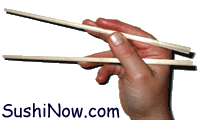Have you ever heard or read something in a sushi bar and did not understand what it was? This is a list of common Vocabulary at a sushi bar.

Types of Sushi
Chirashi – sampler of fish served over a bowl of sushi rice
Donburri – Donburri is like Chirashi but just one kind of fish that you would choose. For example Unagi-Donburri would be Just Unagi (freshwater eel) served over a bowl of sushi rice.
Futomaki – Thick rolled sushi with many ingredients inside and each piece is very large.
Gunkan Nigiri – A type of Nigiri that holds the ingredients like a boat, usually seen when ordering Tobiko, Ikura or Uni.
Hosomaki – Thin Rolled sushi with the Nori (seaweed) on the outside.
Maki –Sushi Rolls (There are many types of Maki, Futomaki, Hosomaki, Temaki, Uramaki, etc.)
Nigiri Sushi – Pieces of fish on top of two balls of sushi rice, sometimes a slice of roasted Nori (seaweed) is put on to bind the fish to the rice and to add flavor and eye appeal.
Sashimi – Only Sliced fish. Raw, cooked or pickled fish cut into 3-5 pieces. Usually presented on top of a few leaves of shiso and grated daikon with wasabi and ginger on the side.
Temaki – Cone shaped hand rolls that are meant to be eaten from the hand like an ice cream cone.
Uramaki – Rice on the outside roll. Sometimes called inside-out roll. This style of sushi has become very popular and is most seen in sushi bars in America. Some people say that it is popular in America because the Seaweed is hidden on the inside of the roll and sushi beginners are less intimidated to eat it.

Sushi Ingredients
Aji – Spanish Mackeral
Akagai – Red Clam
Ama Ebi – Raw Shrimp
Anago – Saltwater Eel
Awabi – Abalone
Ebi – Cooked/Boiled Shrimp
Fugu – Poisonous Blowfish (This can be deadly if it is not prepared correctly. Part of eating this fish is enjoying the sensation of taking your life in your hands. Or really putting your life in the hands of the sushi chef. The Fugu’s organs contains a dangerous neurotoxin, which if ingested will result in paralysis and death in 15 minutes.)
Gari – Pickled Ginger (Bright pink thinly sliced ginger, served on the side of every sushi order. Gari is served as a palate cleanser to be eaten between bites of different types of sushi.)
Gobo – Burdock root. Crunchy slender carrot looking root. Commonly found in Futomaki.
Goma – Sesame Seeds (Black or White)
Hamachi – This fish is also commonly referred to as "Yellowtail" but is really Japanese Amberjack. It has a very buttery flavor and is rich in oils. One of the most common ingredients at a well stocked sushi bar.
Hirame – Flounder/Halibut
Hokkigai – Surf Clam
Hotategai – Scallop
Ika – Squid/Calamari
Ikura – Salmon Roe (large orange carviar with a salty taste.)
Inari – Fried Tofo skin (Commonly used as a pouch and stuffed with rice or a mixture of rice and vegetables.)
Kaiware – Daikon Radish Sprouts
Kajiki – Swordfish (Boycott Swordfish! It is overfished.)
Kani – Crab
Kanikama – Imitation Crab also called Krab (Often found in California Rolls. This is made from various white fish that are pureed, seasoned and cooked into sticks. Also called Kani-kamaboko or Surimi.)
Kanpyo – Pickled Gourd (Dried and pickled Gourd thin strips commonly found in Futomaki.)
Katsuo – Bonito Tuna also known as Skipjack tuna
Maguro – Bluefin Tuna
Mirugai – Horseneck Clam/Geoduck
Natto – Fermented soy bean with a very strong flavor and a mucous consistency
Nori – Seaweed Sheet (Roasted Seaween sheet used as sushi wrapper in sushi rolls. Shredded finely for garnishes.)
Oshinko – Generic term for pickled vegetables but usually people mean Takuan.
Saba – Mackerel
Sake – Salmon (Fresh or Smoked) Pronounced differently than the rice wine (Sake).
Shiso – Japanese mint. Commonly used as garnishes but quite tasty and edible. Used as a wrapper to pick up and eat food. Green Shiso is the most common but red is available also. Very tasty with pickled plum (Umeboshi).
Shiro Maguro – Albacore Tuna (Usually served Tataki style seared or blanched on the outside and raw on the inside.)
Suzuki – Sea Bass
Tai – Snapper/Sea Bream
Tako – Octopus
Takuan – Pickled Daikon (Bright yellow pickled root. Very tasty and colorful in rolls. Some people call this Oshinko.)
Tamago – Sweet Egg Omelette (Cooked in a block. This is the true test of a traditional sushi bar. In Japan, you can tell the quality of a sushi bar by its Tomago. If its bad, people have been known to walk out after tasting it.)
Tobiko – Flying Fish eggs (Bright Red/Orange Caviar that is very crunchy, sweet flavored and often found around the outside of California rolls. Other colors/favors of Tobiko are occasionally seen, Green wasabi flavored, Black squid ink and more...)
Toro – Belly Meat from Bluefin Tuna. (The more fat the higher quality. There are a few "quality levels" associated with toro. They are based upon the amount of fat in the meat. The levels are Toro-Fatty Tuna, Chutoro-Fattier Tuna, and Otoro-Fattiest Tuna.
Umeboshi – Pickled plum (This salty, tart plum helps in digestion and leaves the mouth with a clean feeling. This can be found in a paste or whole plum. Very tasty with Japanese mint (Shiso).
Unagi – Freshwater Eel (Smoked eel and in a sweet sauce this freshwater eel is very common and delicious. Most sushi beginners start with this because almost everyone loves the flavor.)
Uni – Sea Urchin Roe
Uzura – Quail Egg (Usually served raw on top of an order of Tobiko or Uni.
Wasabi – Japanese Horseradish (Spicy Green Paste found on the side of every sushi order. This Green paste is really horseradish with food coloring. Real Wasabi is very expensive and almost never found at a sushi bar. The real wasabi is from a plant that grows in mountainous streams. The root is harvested and grated very finely. Traditionally the root is grated on a shark fin. The taste of real wasabi is sweeter and less spicy than what is commonly found.)

Classic Sushi Rolls
California Roll - Krab, Avocado, and Cucumber Uramaki
(Probably the most popular Sushi EVER! Many sushi bars claim to have created this roll. This sushi roll is great for the sushi beginner just starting out or even the sushi pro looking for an old favorite.)
Hawaiian Roll - Unagi, Macadamia Nuts, Avocado Uramaki
(This decadent roll is very well balanced with texture and flavors. The crunchy nuts add a rich flavor to the creamy avocado and sweet Unagi.)
Kappa Maki - Cucumber Hosomaki
(This sushi roll is very popular with young children because there are only a few ingredients and no strong flavors.)
Philly Roll - Smoked Salmon, Cream Cheese, Avocado, Cucumber Uramaki
(This roll gets its name from the Philidelphia cream cheese and is another very tasty and popular sushi roll.)
Rainbow Roll - UraMaki with different colorful fish pressed on the outside of this roll.
(One of the most colorful rolls, this roll can be made with various ingredients but what they all have in common is the colorful fish that is pressed onto the outside of the roll after the sushi is made.)
Tekka Maki - Maguro/Tuna Hosomaki
(This is another classic roll that is about simplicity. Only a few ingredients but if prepared correctly, will be a fiest for the eyes and mouth.)
Ume Shiso Maki- Umeboshi, Shiso Hosomaki
(This combination is as classic as peanut butter and jelly. The two flavors compliment each other very well and leave a clean feeling in the mouth after eating.)

Other Sushi Terms
Baran – Baran is decorative plastic sushi grass used for its colorful appearance and interesting shapes. Baran is also a functional garnish when used to separate different pieces of sushi.
Bento – A meal in a tray or box with different compartments for each type of food. Usually a couple pieces of Sushi, Tempura, Teriyaki, and Rice.
Edamame – Soy beans that are steamed and served in the shell/pod. Usually garnished and eaten with sea salt and lemon.
Hamachi Kama – Literally meaning the head of the Yellowtail, this is the gill plate from the fish that is broiled with a Ponzu sauce. There is a lot of meat on the gill plate and is commonly seen as a appetizer for 2 people.
Hashi – Chopsticks
Itamae – Sushi Chef (Not to be confused with Shokunin which means master sushi chef.)
Mirin – Sweet rice wine exclusively used in cooking.
Mochi – Pounded rice in paste (Usually seen as Mochi ice cream, which is small scoops of ice cream with a thin layer of Mochi on the outside.)
Ponzu – Traditional sauce that is tart and salty made from simmering soy sauce, lemon juice, Mirin (rice wine), and dried bonito flakes.
Sake – Fermented rice wine (Usually served warm in small cups, or bamboo or wood boxes. Some higher quality sake is often served at room temperature.
Shokunin – Master Sushi Chef
Shoyu – Soy sauce that is made by fermenting wheat, soybeans and seasalt. This does contain wheat.
Sunomono – Pickled cucumber salad
Tamari – Sory Sauce made by fermenting soybeans and seasalt. This contains NO wheat.
Tataki – Style of cooking where a meat or fish is seared or blanched on the outside and raw on the inside.
Tatami – Traditional Japanese flooring made of straw or bamboo. A Tatami room in a restaurant is a private room for your party where everyone must remove your shoes prior to entering.

Useful Phrases
Domo –Thank You
Domo Arigato – Thank you very much
Dozo – Please
Hai – Yes
Kampei – "Cheers" (While drinking)
Konichiwa – How are you?
|



